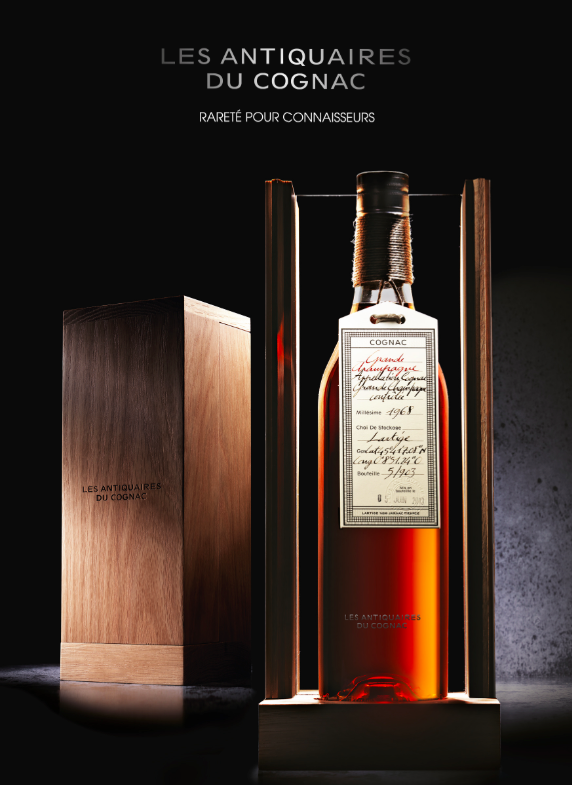These incredible and rare offerings are available for the first time in the United States exclusively through KJS, and are limited to one hundred bottles for the entire country. Like many things French, this is an unique family story that started in the 19th century with a distillery, which now produces single vineyard, single barrel, vintage Cognacs aged over 40 years - a truly rare thing in the commercial world of Cognac.
The Meil Family has built upon acquired ancestral knowledge in selecting and ageing eaux-de-vie for distillation. Over the course of five generations, they have selected out the best barrels of already superlative vintages (originally only for family use), and aged these barrels for decades to bring the alcohol at cask strength down to optimum drinking proof naturally, through evaporation only...an incredible feat of perseverance, vision, and optimism! President David Meil has inherited the family legacy, and in conjunction with Kimberly Jones, is offering these rare Cognacs to select restaurants and fine retail shops.
Each is made from a single cru, never blended, no added oak or caramel, and they stand as the finest examples from the specific terroirs of the Cognac region.
Certified Vintage or in some cases Hors d’Age, these Cognacs are the last of a numbered line – each bottle unique. As in Haute Couture, each bottle is sealed and trimmed by hand with an intricately woven raw cord that holds the label. Each label is hand written by a calligrapher, and the bottle is carefully prepared and packaged in a magnificent solid oak box.
The five Les Antiquaires bottlings have become the official Cognac of
Les Meilleurs Ouvriers de France and were given perfect scores in Le Monde by Roberto Petronio.
Grande Champagne 1968
Grande Champagne, with more than 13,200 hectares under vine to produce ugni blanc, yields exceptionally fine, light eaux-de-vie with a predominantly floral bouquet. However, as they are concentrated and harder when young, Grand Champagne tends to require long ageing in oak casks to achieve full maturity. The cretaceous soil composition of Grand Champagne is formed by a special chalk: Campanian. Like all other chalky soils, it is an accumulation of small fossils, including one found nowhere else: Ostrea vesicularis. The chalk of GC also has faults made up of black pockets of silica and lumps of debased marcasite. The sheer intensity of the soil is reflective in the cru and a major factor in the agebility.
Petite Champagne 1968
Petite Champagne is planted with more than 15,200 hectares of vines. These Petite Champagne eaux-de- vie are very similar to those of Grande Champagne, but without their exceptional finesse. The soil composition of Petite Champagne is Santonian. It is more solid, less chalky but incorporates some of the crumbliness of the Campanion slopes. I always seem to get a nose of hard cheese –almost parmesan-like.
Fins Bois 1973
The Fins Bois surround the three previous crus and are planted with 31,200 hectares of vines for Cognac. They produce round, supple eaux-de-vie that age fairly quickly, with an aroma reminiscent of freshly pressed grapes and red fruit. With such a huge area, the geology is less defined as GC and PC and Borderies. Most of the chalk here are Kimmeridgien and Portlandien types rather than the super porous types of GC and PC. I tend to find Fin Bois more “spring” in flavor.....pretty and on the flirtatious side.
Borderies, Hors d’Age NV Lot B52
This is the smallest of the six crus, with 4,000 hectares of vines devoted to Cognac. The Borderies produce fine, round eaux-de-vie that are smooth and scented with an aroma of violets. They have the reputation of reaching optimum quality after a shorter maturation period than Petite and Grande Champagne eaux-de-vie. I find the most interesting thing about Borderies is, well, the geological borders. This is the only cru whose borders are completely defined with a clear cut mixture of chalk and clay dating from the Jurassic era. The soil is decidedly more decalcified but with a patchwork of chalk intermingling with clay. These Borderies are the strongest Cognac LADC has produced to date—best with cigars! We call this Hors d’Age instead of vintage as we cannot certify this old eaux-de-vie has been distilled between the 1st of October and the 31st of March of this supposed 1952 distillation campaign year. But the first taste confirms its long years maturing in the oak barrels. And it is beyond words.
Grande Champagne, Hors d’Age Lot GC35
As mentioned earlier, Grande Champagne, with more than 13,200 hectares under vine to produce ugni blanc, yields exceptionally fine, light eaux-de-vie with a predominantly floral bouquet. However, as they are concentrated and harder when young, Grand Champagne tends to require long ageing in oak casks to achieve full maturity. The cretaceous soil composition of Grand Champagne is formed by a special chalk: Campanian. Like all other chalky soils, it is an accumulation of small fossils, including one found nowhere else: Ostrea vesicularis. The chalk of GC also has faults made up of black pockets of silica and lumps of debased marcasite. The sheer intensity of the soil is reflective in the cru and a major factor in the agebility.
We call this Hors d’Age instead of vintage as we cannot certify this old eaux-de-vie has been distilled between the 1st of October and the 31th of March of this supposed 1935 distillation campaign year. Only a few drops of this are enough to immediately recognize the old age of this beautiful eaux-de- vie. A monument.
